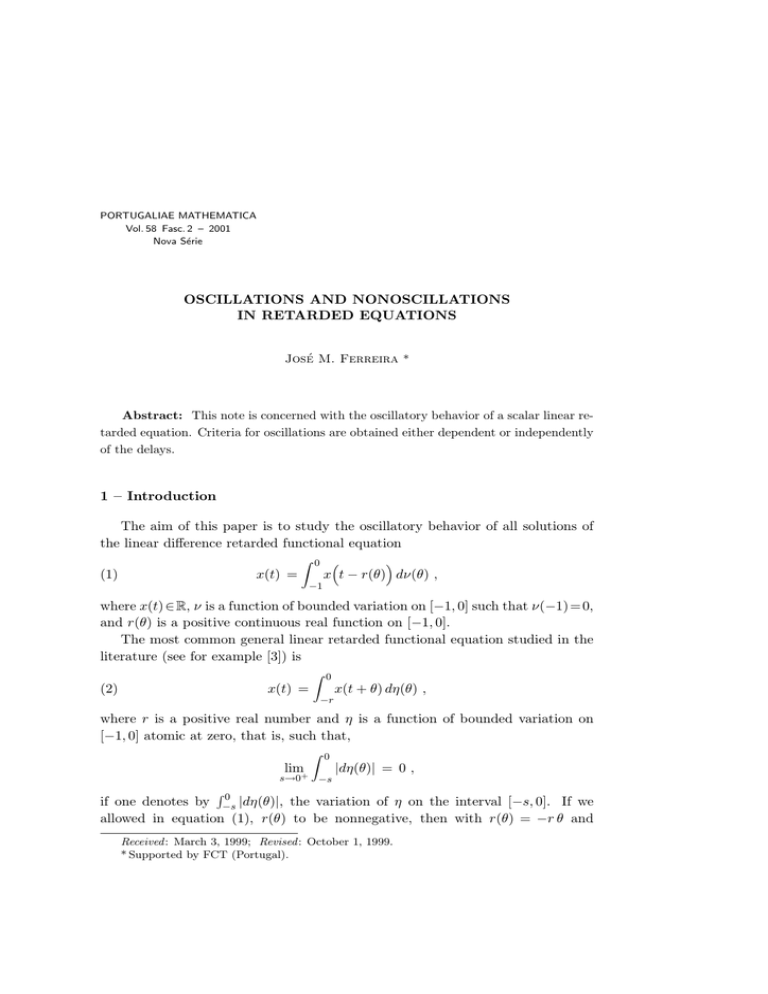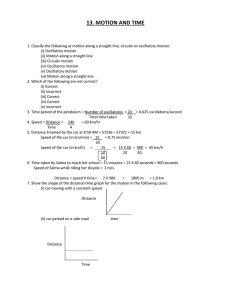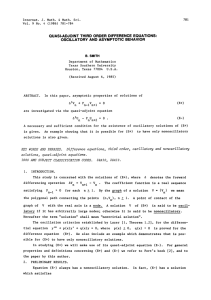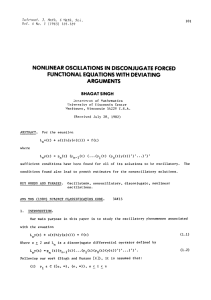OSCILLATIONS AND NONOSCILLATIONS IN RETARDED EQUATIONS
advertisement

PORTUGALIAE MATHEMATICA
Vol. 58 Fasc. 2 – 2001
Nova Série
OSCILLATIONS AND NONOSCILLATIONS
IN RETARDED EQUATIONS
José M. Ferreira *
Abstract: This note is concerned with the oscillatory behavior of a scalar linear retarded equation. Criteria for oscillations are obtained either dependent or independently
of the delays.
1 – Introduction
The aim of this paper is to study the oscillatory behavior of all solutions of
the linear difference retarded functional equation
(1)
x(t) =
Z
0
³
´
x t − r(θ) dν(θ) ,
−1
where x(t) ∈ R, ν is a function of bounded variation on [−1, 0] such that ν(−1) = 0,
and r(θ) is a positive continuous real function on [−1, 0].
The most common general linear retarded functional equation studied in the
literature (see for example [3]) is
(2)
x(t) =
Z
0
x(t + θ) dη(θ) ,
−r
where r is a positive real number and η is a function of bounded variation on
[−1, 0] atomic at zero, that is, such that,
lim
Z
0
s→0+ −s
|dη(θ)| = 0 ,
0
if one denotes by −s
|dη(θ)|, the variation of η on the interval [−s, 0]. If we
allowed in equation (1), r(θ) to be nonnegative, then with r(θ) = −r θ and
R
Received : March 3, 1999; Revised : October 1, 1999.
* Supported by FCT (Portugal).
128
JOSÉ M. FERREIRA
η(θ) = ν(θ/r) atomic at zero, we obtain the class of equations (2). So, there
is actually no gain in generality of (1) with respect to (2), but as we will see
there is some gain in convenience. On the other hand the restriction on r(θ) to
be positive, makes unnecessary any atomicity assumption on ν.
In the case where ν has no singular part, (1) takes the form
(2)
x(t) =
∞
X
ak x(t − rk ) +
k=1
Z
0
a(θ) x(t − r(θ)) dθ ,
−1
where, 0 < σ ≤ rk ≤ τ (k = 1, 2, ...) and the sequence ak and the function a(θ)
are such that
(3)
∞
X
|ak | +
k=1
Z
0
|a(θ)| dθ < ∞ ;
−1
if ν is a step function with a number q of jump points, then we obtain the delay
difference equation
(4)
x(t) =
q
X
aj x(t − rj ) ,
j=1
where the aj are nonzero real numbers and each rj is a positive real number
(j = 1, ..., q). With respect to this equation, (1) corresponds to a more general
situation where coefficients and lags are all included in the function ν.
Considering the value krk = max{r(θ) : −1 ≤ θ ≤ 0}, by a solution of (1)
we mean a continuous function x : [−krk, +∞[ → R, which satisfies (1) for every
t ≥ 0. A solution is said oscillatory whenever it has an infinite number of zeros;
otherwise it will be said nonoscillatory. When all solutions are oscillatory, the
equation is called totally oscillatory.
As, for any given ν and r, a solution of (1) exhibits an integral exponential
boundedness (see [3]), according to [5] we can conclude that it has a totally
oscillatory behavior if and only if the characteristic equation
(5)
1−
Z
0
e−λr(θ) dν(θ) = 0
−1
has no real roots.
Through this characterization, we study in section 2 under which conditions on
ν, one can assure that equation (1) is totally oscillatory or exhibit nonoscillatory
solutions. In [4] this problem is discussed in the more general framework of a
functional differential system of neutral type, but all the results obtained seem
OSCILLATIONS AND NONOSCILLATIONS IN RETARDED EQUATIONS
129
to exclude the present situation. In section 3 we analyze the dependence on the
delay function r(θ), of the totally oscillatory behavior of (1).
By C + we denote the subset of C([−1, 0], R) formed by all positive functions,
r(θ); through krk a metric is introduced in C + . With respect to a delay function,
r ∈ C + , it will be often considered the value
m(r) = min r(θ) > 0 .
−1≤θ≤0
We take the Banach space NBV of all (normalized) real functions of bounded
variation, ν, on [−1, 0], such that ν(−1) = 0, with the norm
kνk =
Z
0
|dν(θ)| ,
−1
0
where by −1
|dν(θ)| we mean the total variation of ν on [−1, 0]. If for a given
θ ∈ [−1, 0] there exists a ε > 0 such that ν is constant in [θ − ε, θ + ε] ([−ε, 0]
if θ = 0, [−1, −1 + ε] if θ = −1) we say that θ is a point of constancy of ν; if
for every ε > 0, sufficiently small, ν is increasing (decreasing) and nonconstant
in [θ − ε, θ + ε] ([−ε, 0] if θ = 0, [−1, −1+ε] if θ = −1) θ will be said a point of
increase of ν (respectively, a point of decrease of ν).
If ν is increasing on [−1, 0], for a given θ ∈ [−1, 0] we shall consider the right
hand oscillation of ν at θ, as the nonnegative real value ων+ (θ) = ν(θ + ) − ν(θ);
analogously the left hand oscillation, ων− (θ), and the oscillation, ων (θ), of ν at θ,
will be given, respectively, by ων− (θ) = ν(θ)−ν(θ − ) and ων (θ) = ων+ (θ)+ων− (θ) =
ν(θ + ) − ν(θ − ).
As is well known, any function ν ∈ N BV , can be decomposed as the difference
of two increasing functions α and β: ν = α − β. However, this decomposition is
not unique. A particular decomposition of ν is given by
R
ν =p−n ,
(6)
where by p and n we denote, respectively, the positive and negative variation
of ν, which are defined as follows. For each θ ∈ [−1, 0], let Pθ be the set of all
partitions P = {−1 = θ0 , θ1 , ..., θn = θ} of the interval [−1, θ] and to each P ∈ Pθ
associate the sets
n
A(P ) = j : ν(θj ) − ν(θj−1 ) > 0
Then p and n are defined as
p(θ) = sup
o
½ X ³
j∈A(P )
n(θ) = sup
and
n
o
B(P ) = j : ν(θj ) − ν(θj−1 ) < 0 .
´
ν(θj ) − ν(θj−1 ) : P ∈ Pθ
¾
,
¾
½ X ¯
¯
¯
¯
¯ν(θj ) − ν(θj−1 )¯ : P ∈ Pθ ,
j∈B(P )
130
JOSÉ M. FERREIRA
(whenever A(P ) or B(P ) are empty, we make p(θ) = 0, n(θ) = 0). One easily
sees that both p and n are increasing functions such that ν(θ) = p(θ) − n(θ),
for every θ ∈ [−1, 0]. Moreover, with respect to the total variation of ν on the
interval [−1, θ],
θ
Z
V (θ) =
|dν(s)| ,
−1
we have V (θ) = p(θ) + n(θ), for every θ ∈ [−1, 0].
2 – Oscillations and nonoscillations
For given ν ∈ N BV and r ∈ C + , define the function
g(λ) =
Z
0
e−λr(θ) dν(θ) .
−1
This function has some general features which will be important in the sequel.
For example, by uniform convergence of the exponential series, we have
g(λ) =
∞
X
k=0
mk
(−λ)k
,
k!
where, for k = 1, 2, ...,
mk =
Z
0
(r(θ))k dν(θ) .
−1
As |mk | ≤ krkk kνk, for k = 1, 2, ..., this series converges absolutely and uniformly
for λ on compact sets of the complex plane. Thus g(λ) is analytic in R and termby-term differentiation implies that
0
g (λ) = −
Z
0
r(θ) e−λr(θ) dν(θ) .
−1
Moreover, since for λ ≥ 0,
|g(λ)| ≤ e−λm(r) kνk ,
we have that,
lim g(λ) = 0 .
λ→+∞
These facts enable us to conclude the following characterization of total oscillatory behavior.
131
OSCILLATIONS AND NONOSCILLATIONS IN RETARDED EQUATIONS
Lemma 1.
every real λ.
Equation (1) is totally oscillatory if and only if g(λ) < 1, for
Proof: If g(λ) < 1 for every λ ∈ R, then (5) has no real roots. Conversely,
assuming that for some real number, λ0 , we have g(λ0 ) ≥ 1, by continuity, there
exists a real λ1 such that g(λ1 ) = 1, which is contradictory.
In order for (1) to be totally oscillatory, by the same arguments, one cannot
have, g(λ) → +∞, as λ → −∞. This situation would give entail the existence of
at least one nonoscillatory solution.
This is the case in the following theorems, where ν is decomposed as ν =
α − β, with α and β increasing in [−1, 0] (in particular, the decomposition (6) is
included); g(λ) can then be rewritten as
Z
g(λ) =
0
e−λr(θ) dα(θ) −
−1
Z
0
e−λr(θ) dβ(θ) .
−1
Theorem 1. Let θ0 ∈ [−1, 0] be such that krk = r(θ0 ). If
n
o
max ωα+ (θ0 ), ωα− (θ0 ) > kβk ,
then (1) has, at least, a nonoscillatory solution.
Proof: Assume, for example, ωα+ (θ0 ) > kβk. For every real λ and ε > 0
sufficiently small, we obtain, by application of a mean value property, that
Z
0
e−λr(θ) dα(θ) ≥
−1
Z
θ0 +ε
³
´
e−λr(θ) dα(θ) = e−λr(θ0 +δε) α(θ0 + ε) − α(θ0 ) ,
θ0
for some 0 ≤ δ ≤ 1, depending upon, r, θ0 and ε. Therefore, making ε → 0+ , we
have
Z
0
−1
e−λr(θ) dα(θ) ≥ e−λr(θ0 ) ωα+ (θ0 ) = e−λkrk ωα+ (θ0 ) .
On the other hand, for every real λ < 0,
and consequently
¯Z
¯
¯
¯
0
e
−1
−λr(θ)
¯
¯
dβ(θ)¯¯ ≤ e−λkrk kβk ,
³
´
g(λ) ≥ e−λkrk ωα+ (θ0 ) − kβk .
Thus g(λ) → +∞, as λ → −∞, and so (1) has, at least, a nonoscillatory solution.
132
JOSÉ M. FERREIRA
Theorem 2. Let r ∈ C + be such that its absolute maximum is attained at a
single point θ0 ∈ [−1, 0]. If θ0 is a point of increase of α and a point of constancy
of β, then (1) has, at least, a nonoscillatory solution.
Proof: In fact, assuming, for example, that θ0 ∈ ]− 1, 0[, we have for some
ε > 0,
g(λ) ≥
Z
θ0 +ε
e−λr(θ) dα(θ) −
θ0 −ε
Z
θ0 −ε
e−λr(θ) dβ(θ) −
−1
Z
0
e−λr(θ) dβ(θ) .
θ0 +ε
Take 0 < δ < ε such that
m0 =
min
θ0 −δ≤θ≤θ0 +δ
r(θ) >
Since for every real λ < 0, it holds that
¯Z
¯
¯
¯
θ0 −ε
e
−λr(θ)
dβ(θ) +
−1
we obtain, by consequence,
³
Z
0
e
θ0 +ε
−λr(θ)
M1 =
M2 =
max
−1≤θ≤θ0 −ε
max
θ0 +ε≤θ≤0
r(θ) ,
r(θ) .
¯
³
´
¯
dβ(θ)¯¯ ≤ e−λM1 + e−λM2 kβk ,
´
g(λ) ≥ e−λm0 α(θ0 + δ) − α(θ0 − δ) − (e−λM1 + e−λM2 ) kβk
≥ e
−λm0
·³
´
α(θ0 + δ) − α(θ0 − δ) − (e
λ(m0 −M1 )
−e
λ(m0 −M2 )
¸
) kβk ,
and so, also in this case, g(λ) → +∞, as λ → −∞.
Remark 1. These two results are similar but of different kind. In fact, θ0 is
a point of increase of α if ωα (θ0 ) > 0, which occurs whenever either ωα+ (θ0 ) > 0,
or ωα− (θ0 ) > 0; that is, relatively to θ0 and α, the assumption in the first theorem implies the assumption in the second. However, the assumptions on β are
completely independent.
Corollary 1. Let r ∈ C + be such that its absolute maximum is attained at
a single point θ0 ∈ [−1, 0]. If θ0 is a point of increase of ν, then (1) has, at least,
one nonoscillatory solution.
Proof: Notice that in this case, for some ε > 0, the negative variation, n(θ),
of ν, is constant on [θ0 − ε, θ0 + ε] and so the corresponding positive variation
p(θ) = ν(θ) − c, on that interval, for some real number c. Then applying the
Theorem 2 to the decomposition (6) we obtain the statement.
OSCILLATIONS AND NONOSCILLATIONS IN RETARDED EQUATIONS
133
Example 1. Consider the equation
x(t) =
0
Z
sin(2 π θ) x(t − r(θ)) dθ ,
−1
where the delay function, r(θ), is any strictly decreasing positive function in
Rθ
[−1, 0]. The corresponding function of N BV is ν(θ) = −1
sin(2 π s) ds, which
has a point of increase at θ = −1, where r(θ) attains its absolute maximum.
Hence the equation has at least, a nonoscillatory solution.
The above corollary can also be applied, for example, to equation (3), for the
case where a(θ) is the null function, that is to equation
(7)
x(t) =
∞
X
ak x(t − rk ) ,
k=1
where 0 < σ ≤ rk ≤ τ (k = 1, 2, ...) and the ak 6= 0 (k = 1, 2, ...) are such that
∞
X
|ak | < ∞ .
k=1
Corollary 2. If r1 > ... > rk > ..., then (7) has a nonoscillatory solution
provided that a1 > 0.
Theorem 3. Let θ0 ∈ [−1, 0] be such that krk = r(θ0 ) and ω = ωβ (θ0 ) > 0.
For
k(θ) =
if
1/ω,
if r(θ) = krk ,
1
ω r(θ)/krk
µ
r(θ)
krk
¶r(θ)/krk µ
Z
1−
r(θ)
krk
¶1−r(θ)/krk
,
0
k(θ) dα(θ) < 1 ,
−1
then (1) is totally oscillatory.
Proof: We have, for every real λ, g(λ) < 1 if and only if
Z
0
e−λr(θ) dα(θ)
−1
1+
Z
< 1.
0
e
−1
−λr(θ)
dβ(θ)
if r(θ) 6= krk ,
134
JOSÉ M. FERREIRA
Since,
Z
0
−1
e−λr(θ) dβ(θ) ≥ e−λkrk ωβ (θ0 ) ,
(1) becomes totally oscillatory, provided that
Z
0
−1
dα(θ)
< 1,
eλr(θ) + ω eλ(r(θ)−krk)
for every real λ.
As for each θ ∈ [−1, 0], the function eλr(θ) + ω eλ(r(θ)−krk) , for λ in the real
line, is bounded below, we can analyze the value
sup
λ∈R
eλr(θ)
1
.
+ ω eλ(r(θ)−krk)
If θ ∈ [−1, 0] is such that r(θ) = krk, this supremum is 1/ω. In fact, in that case
eλkrk + ω > ω, for every real λ and eλkrk + ω → ω as λ → −∞. If θ ∈ [−1, 0] is
such that r(θ) 6= krk, since the only stationary point of eλr(θ) + ω eλ(r(θ)−krk) is
1
log ω(krk−r(θ))
, we have that
λ = krk
r(θ)
³
min eλr(θ) + ω eλ(r(θ)−krk)
λ∈R
´
³
=
ω krk − r(θ)
r(θ)
´ r(θ)/krk
krk
,
krk − r(θ)
and consequently,
r(θ)
1
1
= r(θ)/krk
sup λr(θ)
λ(r(θ)−krk)
krk
+ωe
ω
λ∈R e
µ
¶r(θ)/krk µ
r(θ)
1−
krk
¶1−r(θ)/krk
Notice that if θ 0 ∈ [−1, 0] is such that r(θ 0 ) = krk then, as θ → θ 0 ,
1
ω r(θ)/krk
µ
µ
1
,
ω
¶r(θ)/krk
→ 1,
¶1−r(θ)/krk
→ 1.
r(θ)
krk
r(θ)
1−
krk
→
Therefore the function k(θ) is continuous on [−1, 0] and if
Z
0
k(θ) dα(θ) < 1 ,
−1
equation (1) is totally oscillatory.
.
OSCILLATIONS AND NONOSCILLATIONS IN RETARDED EQUATIONS
135
By separation of positive and negative terms, the equation (7) can be rewritten
as
(8)
x(t) =
∞
X
ck x(t − γk ) +
k=1
∞
X
k=1
bk x(t − βk ) ,
with ck ≥ 0, bk ≤ 0 (k = 1, 2, ...) and
∞ ³
X
´
|ck | + |bk | < ∞ .
k=1
Assuming 0 < γ < ... < γk < ... < γ1 , 0 < β < ... < βk < ... < β1 (k = 2, 3, ...),
γ1 < β1 and b1 < 0, the conditions for applying Theorem 3 are met, which yields
as a corollary the following extension of [1, Theorem 3] (see also [2, Chapter 7]).
Corollary 3. If
µ
¶
∞
X
ck γk γk /β1
k=1
β1 |b1 |
(β1 − γk )(β1 −γk )/β1 < 1 ,
then (8) is totally oscillatory.
3 – Oscillations and the delays
For a given ν ∈ N BV , looking to the real function g, introduced before, as a
function of the pair (λ, r) in R × C+ ,
g(λ; r) =
let
Z
0
e−λr(θ) dν(θ) ,
−1
n
o
K = r ∈ C + : g(λ; r) < 1, for every λ ∈ R ,
be the set of all delays for which the corresponding equation (1) is totally oscillatory.
First notice, that if K is not empty then it has the following cone property:
r ∈ K ⇒ γ r ∈ K,
for each γ > 0 ,
as one easily sees through the relation
g(λ; γ r) = g(γλ; r) ,
valid for every real λ and γ.
136
JOSÉ M. FERREIRA
Two extreme cases of K are referred to in the next two examples.
Example 2. If ν is such that
ν(0) =
Z
0
dν(θ) = 1 ,
−1
we have K = ∅, since then g(0; r) = 1, for every r ∈ C + .
Example 3. For the equation
x(t) = c
Z
0
x(t − r(θ)) dθ ,
−1
with c 6= 0, it holds that,
g(λ; r) = c
Z
0
e−λr(θ) dθ .
−1
Then either K = ∅ or K = C + , according to whether c > 0 or c < 0, respectively.
In fact, if c > 0 then K = ∅, since for each r ∈ C + , g(λ; r) → +∞, as λ → −∞;
if c < 0, the range of g is contained in ]− ∞, 0[ and so K = C + .
When K = C + , equation (1) will be said totally oscillatory globally in the
delays. The opposite case, K = ∅, means that for every delay function r ∈ C +
the corresponding equation (1) has at least one nonoscillatory solution. Another
example of these two extreme situations is given in the following theorem.
Theorem 4.
(i) If ν is decreasing, then (1) is totally oscillatory globally in the delays.
(ii) If ν is increasing and ν(0) > 0, then for each r ∈ C + the corresponding
equation (1) has at least one nonoscillatory solution.
Proof: (i) If ν is decreasing, then for each r ∈ C + and every λ, real, we
have g(λ; r) ≤ 0 and consequently K = C + .
(ii) Notice that if ν has a point of increase at some θ0 ∈ [−1, 0], then taking
r ∈ C + such that r(θ0 ) = krk and r(θ) 6= krk for every θ 6= θ0 , by the Corollary 1,
the corresponding equation has at least one nonoscillatory solution and (1) is not
totally oscillatory globally in the delays. Furthermore, if ν is increasing, then for
each r ∈ C + , we have
g(λ; r) ≥ e−λm(r) ν(0) ,
for every real λ ≤ 0, and ν(0) > 0 implies that g(λ; r) → +∞, as λ → −∞, and
so K = ∅.
OSCILLATIONS AND NONOSCILLATIONS IN RETARDED EQUATIONS
137
In the following theorem the case K = C + is characterized for an important
class of functions ν.
Theorem 5. Let ν be a right or left hand continuous step function. Then
(1) is totally oscillatory globally in the delays if and only if ν is decreasing.
Proof: Let {θ0 , ..., θq } be a partition of [−1, 0] (θ0 = −1, θq = 0) such that,
ν(θ) = νj for θ ∈ ]θj−1 , θj [, j = 1, ..., q. Suppose that (1) is totally oscillatory
globally in the delays. Since ν(−1) = 0, if ν is right hand continuous then ν(θ) = 0
on [−1, θ1 [ and so ν1 = 0. Otherwise, if ν1 > 0, then ν is increasing on [−1, θ1 [
and −1 is a point of increase of ν which cannot occur. So, necessarily ν 1 ≤ 0,
and ν is decreasing on [−1, θ1 [.
If ν is not decreasing on [−1, 0[, then for some j ∈ {1, ..., q − 1}, we have
νj < νj+1 . Therefore, with ν either left or right continuous at θj , ν is increasing
on ]θj−1 , θj+1 [ and θj is a point of increase of ν, which is contradictory. Hence ν
is necessarily decreasing on [−1, 0[.
Finally, if ν is left hand continuous then ν(0) = νq , and ν becomes decreasing
on [−1, 0]. Otherwise, if ν(0) > νq , ν is increasing on ]θq−1 , 0] and zero is again a
point of increase of ν, which contradicts the hypothesis of (1) be totally oscillatory
globally in the delays.
As a consequence, the Remark 2 of [1] is obtained.
Corollary 4. Equation (4) is totally oscillatory globally in the delays if and
only if aj < 0 for j = 1, ..., q.
Proof: In this case ν can be taken as a step function of the form
ν(θ) =
q
X
H(θ − θj ) aj ,
j=1
where H denotes the Heaviside function, and −1 < θ1 < ... < θq < 0; ν is right
hand continuous at each point θj , j = 1, ..., q. Since any of the aj cannot be zero,
ν is decreasing if and only if aj < 0 for every j = 1, ..., q.
Remark 2. This situation can be extended to equation (7). Considering a
strictly increasing sequence, θk , in ]− 1, 0], converging to zero, and
ν(θ) =
∞
X
k=1
H(θ − θk ) ak ,
138
JOSÉ M. FERREIRA
the arguments used in Theorem 5 can be repeated to show that (7) is totally
oscillatory globally in the delays if and only if ν is decreasing, that is, if and only
if ak < 0 for k = 1, 2, ... .
REFERENCES
[1] Ferreira, J.M. – Oscillations in difference equations, in “International Conference
on Differential Equations” (C. Perelló, C. Simó and J. Solà-Morales, Eds.), World
Scientific, 1993, pp. 484-490.
[2] Györi, I. and Ladas, G. – Oscillation Theory of Delay Differential Equations,
Oxford University Press, 1991.
[3] Hale, J.K. and Verduyn Lunel, S.M. – Introduction to Functional Differential
Equations, Springer, 1993.
[4] Kirchner, J. and Stroinski, U. – Explicit oscillation criteria for systems of neutral differential equations with distributed delay, Differential Equations and Dynam.
Systems, 3 (1995), 101–120.
[5] Krisztin, T. – Oscillation in linear functional differential systems, Differential
Equations and Dynam. Systems, 2 (1994), 99-112.
José M. Ferreira,
Instituto Superior Técnico, Departamento de Matemática,
Av. Rovisco Pais, 1049-001 Lisboa – PORTUGAL







